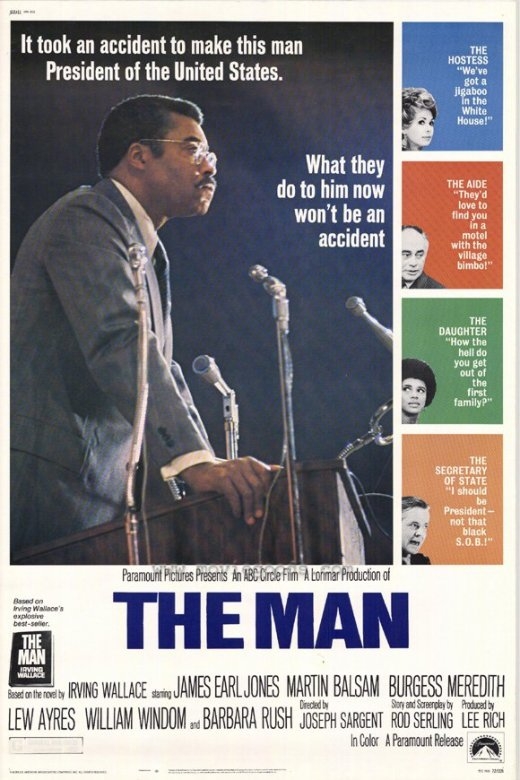
ANDREW’S VIDEO VAULT @ The Rotunda 4014 Walnut Street, Philadelphia PA
Thursday November 13th 2008 8PM Free!
THE MAN (1972, directed by Joesph Sargent, 93 minutes, U.S.)
HAIL (1973, directed by Fred Levinson, 88 minutes, U.S.)
 BY DAN BUSKIRK FILM CRITIC Thirty-six years ago, it took the mind of Twilight Zone-creator Rod Serling to imagine the audacious history we’re now living. His 1972 script for The Man tells the story of the first African American President of the U.S. and there could be no more timely booking for this obscurity’s reappearance than tonight on a Presidential double-bill at Andrew’s Video Vault.
BY DAN BUSKIRK FILM CRITIC Thirty-six years ago, it took the mind of Twilight Zone-creator Rod Serling to imagine the audacious history we’re now living. His 1972 script for The Man tells the story of the first African American President of the U.S. and there could be no more timely booking for this obscurity’s reappearance than tonight on a Presidential double-bill at Andrew’s Video Vault.
Made for ABC-TV but instead quietly dumped into theaters, The Man tells the story of Douglass Dilman, the President Pro Temp of the Senate who through disaster finds himself bumped up the line of succession and into the Oval Office. Engagingly portrayed by Mr. Gravitas James Earl Jones, Dilman is a quietly unambitious former Professor who initially seems content to serve out the brief remainder of the dead Prez’s term acting as an unassuming figurehead for the powers around him. Only the conscious of his college radical daughter inspires him rise from puppet to full-blown President.
There are few actors as respected as James Earl Jones although today he’s probably more recognizable as the voice of the villainous empire (AT&T or Darth Vader, take your pick) than he is for roles as juicy as this one. When first alerted by the Secret Service of his change in title he can not stop his hands from shaking. Later, he makes meek jokes about sitting quietly at the table while policy is decided all around him. Finally, when challenged at a press conference by a black reporter, he speaks frankly about race and justice in America and South Africa, and his world erupts.
Director Joseph (Taking of Pelham One, Two, Three) Sargent keeps the story moving with his workman-like style but it is Serling’s subversive script, the last he would see produced before his untimely death in 1975, that gives The Man its strength. Containing his trademark mixture of philosophy and pulp thrills, Serling revels in showing the machinations of the sleazy Southern Senator who seeks to bring Dilman down (played by Burgess Meredith he proudly claims “I know six states ready to secede from the Union right now”) and later gives Dilman a beautifully eloquent and angry diatribe on the moral bankruptcy of violence.
Serling also supplies moments we can now imagine our President-elect living in January, meditating at the feet of the Lincoln Memorial, surveying the portraits of the past white faces in the oval office and reveling in the awe of living in that most exclusive of addresses, one coincidentally built by the labor of slaves. As his daughter spins around soaking in the sights President Dilman interrupts to caution, “keep in mind, we’re only subletting this place”.
Another equally difficult-to-see feature fills out the bill, 1973’s political satire Hail. Shot in 1970, Hail captures the counterculture’s fears and fantasies about the Nixon Presidency. Hail sure knows how to open dramatically; the Secretary of Health (longtime character actor Richard B. Shull) is seen carefully placing a briefcase bomb beneath the table during a Presidential cabinet meeting. The film flashes back to show our President (lantern-jawed Dan Resin) plotting comedic assassinations of his enemies in labor and the courts as well as building prison camps for the Woodstock generation. The film’s satire labors to find a tone similar to Dr. Strangelove or Robert Downey Sr.’s Putney Swope yet it is so overflowing with broad caricatures there is no straight men off of which to play its smarty-pants comedy. Hail is a passionate misfire though, you can sense the political doom felt by it writers, a pit-of-stomach ache that feels only too similar to these rapidly expiring Bush years.
